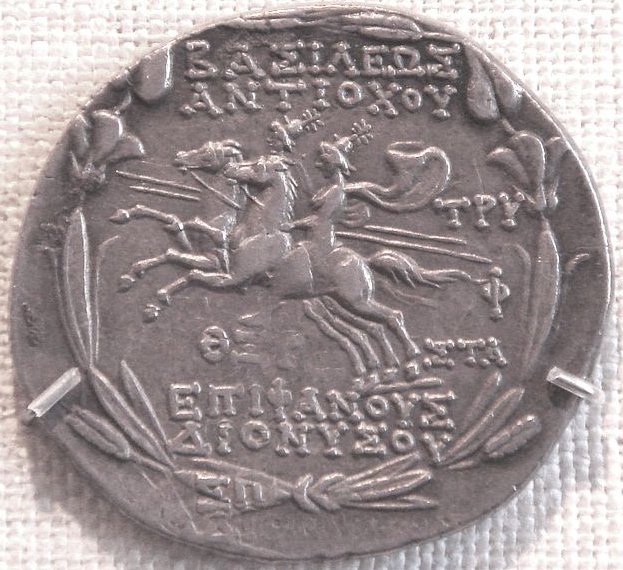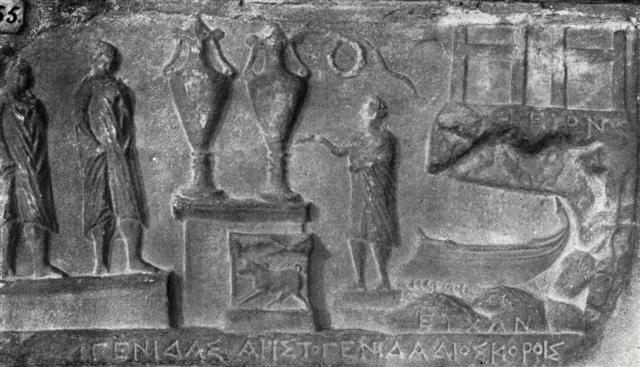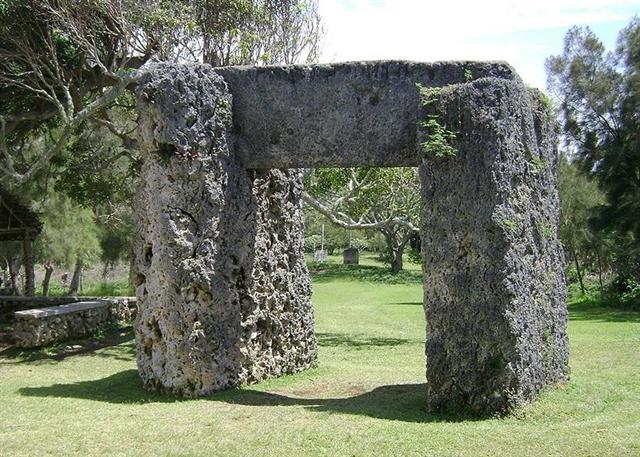426. Once again. When Spica rose together
with the Sun in the Age of Virgo this was around 80 days after
the Sun had been at Argo Navis at 0h. Naos (*121) =
Bharani (*41) + *80, and therefore Naos should have risen with the
Sun in "June 9 (160).

*41.4 + *80 = *121.4 and 121.4 / 365.25 *
26000 was 8642 years before the time of rongorongo. 8642
- 1842 AD = 6800 BC, when the northern vernal
equinox had been in Cancer. 12500 BC (cfr the
illustration above) - 6800 BC = 5700 years corresponds
to 5700 / 26000 * 365.25 = 80 right ascension days,
which means that in the age of Cancer (6800 BC) the
thong which held it all together would have been around
June 9 (80 + 80):
... Proclus
informs us that the fox star nibbles continuously at the
thong of the yoke which holds together heaven and earth;
German folklore adds that when the fox succeeds, the
world will come to its end. This fox star is no other
than Alcor, the small star g near zeta Ursae
Majoris (in India Arundati, the common wife of
the
Seven Rishis, alpha-eta Ursae) ...
However, 6800 BC was not exactly in the age of
Cancer because Praesepe (the Beehive,
ε Cancri) was at 0h in 7000 BC. Maybe we
should instead say in the age of Argo Navis.
|
JUNE 7 |
8 |
9 |
10 (161 = 241 - 80) |
11 |
12 |
|
... The month, which takes its name from
Juppiter the oak-god, begins on June
10th and ends of July 7th. Midway comes
St. John's Day, June 24th, the day on
which the oak-king was sacrificially
burned alive. The Celtic year was
divided into two halves with the second
half beginning in July, apparently after
a seven-day wake, or funeral feast, in
the oak-king's honour
...
 |
 |
 |
 |
 |
 |
 |
|
*Ca14-18 |
*Ca14-19 |
*Ca14-20 (383) |
(6 + 378) |
*Ca14-22 |
*Ca14-23 |
|
CLOSE TO THE SUN: |
|
(461 - 182 = 279) |
7 (*200) |
8 (281) |
Oct 9 |
10 |
11 (284) |
|
"Aug 26 |
27 |
28 (*160) |
29 (241 = 282 - 41) |
30 |
31 |
|
AL DAFĪRAH (Tuft) = β Com. Ber.
(199.4) |
σ Virginis (200.4)
*159.0 = *200.4 - *41.4 |
γ Hydrae (201.0), ι Centauri (201.4) |
Al Simāk-12 (Lofty) /
Chitra-14 (Bright One) /
Horn-1 (Crocodile) /
Sa-Sha-Shirū-20
(Virgin's Girdle) /
ANA-ROTO-3 (Middle pillar)
MIZAR =
ζ
Ursae Majoris (202.4), SPICA =
α
Virginis, ALCOR = 80 Ursae Majoris
(202.7)
SADALMELIK (α Aquarii)
*161.0 = *202.4 - 41.4 |
71 VIRGINIS
(203.6) |
no star listed (204) |
 |
|
CLOSE TO THE FULL MOON: |
|
(86 + 375 = 461) |
(462 - 366 = 96) |
April 7 |
8 |
9 (465) |
10 (100) |
|
"Febr 23 (6 * 70) |
24 (462 - 41 = 421)
|
25 |
26 |
27 (*345) |
28 (59 = 2 * 29½) |
|
DEC 7 |
8 |
9 |
10 |
11 (345) |
12 (*266) |
|
1h (15.2)
β Phoenicis (15.1), υ Phoenicis, ι
Tucanae (15.6), η Ceti, ζ Phoenicis
(15.7) |
Al Batn Al Hūt-26 (Belly of the Fish) /
Revati-28 (Prosperous) /
1-iku (Field Measure)
MIRACH (Girdle) = β Andromedae, KEUN MAN
MUN (Camp's South Gate) = φ Andromedae
(16.0),
ANUNITUM = τ Piscium
(16.5),
REVATI (Abundant) = ζ Piscium
(16.9)
REGULUS
(α Leonis) |
ν Phoenicis (17.4), κ Tucanae (17.6)
*342.0 = *383.4 - *41.4 |
no star listed (18) |
ADHIL (Garment's Train) = ξ Andromedae
(19.3), θ Ceti (19.7) |
KSORA (Knee) = δ Cassiopeiae
(20.1), ω Andromedae (20.6), γ Phoenicis
(20.8) |
|
... Though Andromeda has its roots most
firmly in the Greek tradition, a female
figure in Andromeda's place appeared in
Babylonian astronomy. The stars that
make up Pisces and the middle portion of
modern Andromeda formed a constellation
representing a fertility goddess,
sometimes named as Anunitum or
the Lady of the Heavens ...
 |
|
DEC 7 |
8 |
9 |
10 |
11 (345) |
12 (*266) |
The year was divided into twin
halves by Spica and Heze on one side and by the
Pegasus Square and Andromeda on the other.
... On votive reliefs they are
depicted with a variety of symbols representing
the concept of twinhood, such as the dokana
(δόκανα - two upright pieces of wood connected by
two cross-beams), a pair of amphorae, a pair of
shields, or a pair of snakes. They are also
often shown wearing felt caps, above which stars
may be depicted ...

The Greek capital letter H (eta,
η) was
similar to the δόκανα, although with the pair of
uprights connected by only a single cross-beam,
as if the twins had been partly separated. Such a
separation could have been due late in March. There were twice
π (Π) for measuring
a circle and you could begin anywhere. Although
some places were better than most:
|
Delta (→ 4) |
δ Andromedae |
8.4 |
March 29 (88) |
0 |
|
|
Eta (→ 7) |
η Phoenicis |
9.4 |
March 30 |
1 |
|
|
η Andromedae |
11.4 |
April 1 (91) |
3 |
|
|
Gamma (→ 3) |
Cih (Whip) (γ Cassiopeiai) |
12.4 |
April 2 (92) |
4 |
|
|
1 |
Al Sharatain |
Pair of Signs |
β Arietis (Sheratan), γ (Mesarthim) |
27.4 |
April 17 (107) |
19 |
|
|
Musca Borealis |
35 (Head of the Fly), 39 (Kaffaljidhma), and 41 Arietis (Bharani) |
41.4 |
May 1 (121) |
33 |
0 |
|
2 |
Al Dabarān |
Follower |
α Tauri (Aldebaran), θ¹, θ²´, γ (Hyadum I), δ (Hyadum II), ε (Ain) |
63.4 |
May 23 (143) |
55 |
22 |
|
3 |
Al Hak'ah |
White Spot |
λ Orionis (Heka), φ¹, φ² |
83.4 |
June 12 (163) |
75 |
42 |
|
4 |
Al Han'ah |
Brand |
γ Gemini (Alhena), μ (Tejat Posterior), ν, η (Tejat Prior), ξ (Alzirr) |
93.4 |
June 22 (173) |
85 |
52 |
|
5 |
Al Dhirā' |
Forearm |
α Gemini (Castor), β (Pollux) |
113.4 |
July 12 (193) |
105 |
72 |
|
6 |
Al Nathrah |
Gap |
ε Cancri (Beehive) |
130.4 |
July 29 (210) |
123 |
90 |
|
7 |
Al Tarf |
End |
ξ Cancri, λ Leonis (Alterf) |
143.4 |
Aug 11 (223) |
135 |
102 |
|
8 |
Al Jabhah |
Forehead |
η Leonis (Al Jabhah), α (Regulus), ζ (Adhafera), γ (Algieba) |
152.4 |
Aug 20 (232) |
144 |
111 |
|
9 |
Al Zubrah |
Mane |
δ Leonis (Zosma), θ (Coxa) |
169.4 |
Sept 6 (249) |
161 |
128 |
|
10 |
Al Sarfah |
Turn |
β Leonis (Denebola) |
178.3 |
Sept 15 (258) |
170 |
137 |
|
11 |
Al Áwwā' |
Barker |
β (Alaraph), η (Zaniah), γ (Porrima), δ (Minelauva), ε Virginis (Vindemiatrix) |
191.5 |
Sept 28 (271) |
183 |
150 |

| Amo. To carry on one's shoulders: O Yetú i-amo-ai te tatauró ki ruga ki-te maúga Kalvario. Jesus carried his cross up to the Calvary. Amoga, bundle; to tie in a bundle: he-amoga i te hukahuka, to tie a bundle of wood. Vanaga. 1. A yoke, to carry; amoga, burden, load. 2. To bend, to beat a path. Churchill. Âmo. 1. To clean, to clean oneself: he-âmo i te umu, to clean the earth oven; ka-âmo te hare, ka haka-maitaki, clean the house, make it good; he-âmo i te ariga, to clean one's face wetting it with one's hand. 2. Clear; ku-âmo-á te ragi, the sky is clear. 3. To slip, to slide, to glide (see pei-âmo). Ámoámo, to lick up, to lap up, to dry; to slap one's body dry (after swimming or bathing): he-âmoâmo i te vaihai rima. Vanaga. Amoamo. 1. To feed, to graze. 2. To spread, to stretch (used of keete). Churchill.

... During his coronation year king Taufa'ahau Tupou IV advanced the theory that the Ha'amonga stones must have served a greater purpose than the more obvious function as a gateway. This proved to be the case when closer investigation revealed a secret mark on the lintel (= threshold) stone ... On June 21st 1967 at dawn his majesty was present at this place and it was a thrilling moment when the sun rose at the exact point indicated by his interpretation of the lines etched on the great stone ... |
|








